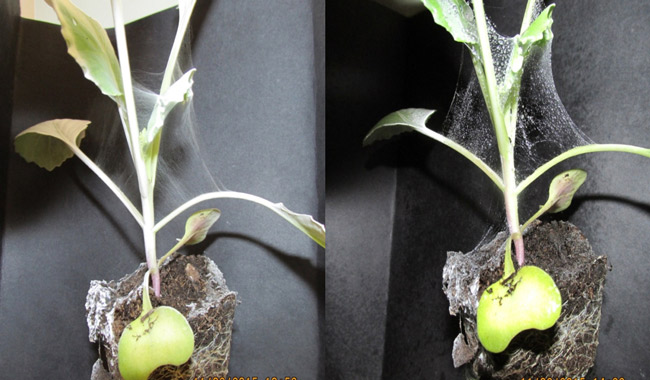
At work ... Nano-webs on plants.
School of Pharmacy Senior Lecturer Dr Greg Walker has received a $25,000 grant from the KiwiNet Emerging Innovator Fund to aid his mission to protect our crops from pests without using harmful chemicals.
The grant, awarded to help early-career scientists with a clever new idea to work closely with business to take it to market, is one of ten made possible by a donation from the Norman F. B. Barry Foundation.
Spider web-like system
Inspired by nature, Dr Walker has developed a spider web-like system to protect plants and crops against pests, using his pharmaceutical knowledge.
Dr Walker says electrospun nano-webs are sprayed or draped over the plants like a spider web, but on a smaller scale.
“We're mimicking nature as the nano-webs, similar to spider webs, are not water soluble and are resistant to environmental conditions like rain and wind. In this way we can prolong the time the active agent, in this case the biocontrol, is on the plant to provide protection.”
Environmentally friendly
The nature-inspired system provides an environmentally friendly way to protect crops from pests without the need for harmful chemicals. The nano-webs — food-grade polymers that are not harmful if eaten by humans — also carry bio-active compounds which harm pests.

Dr Greg Walker.
Dr Walker's mission now is to commercialise the technology: “I'm very excited as the grant will allow me to build a mobile prototype electrospinning device. This will enable us to carry out tests in the field and demonstrate the technology to potential horticulture and cropping industry players and bioactive suppliers. It will also allow us to perfect the bioactive formulations.”
According to Dr Walker, the technology has the potential to offer several important advantages over conventional agricultural spray systems.
Bioactive compound
“The nano-webs contain the bioactive compound which means the compound stays in contact with the plant longer, improving its effectiveness and reducing the effects of the weather. There is also no undesirable spray drift and run-off, and because the nano-web is visible there is less chance of overspray, reducing costs to growers.”
Gavin Clark, Director of the Research and Enterprise Office at the University of Otago says, “Greg has established a group dedicated to developing electrospinning as a way to deliver bioactives and is skilled in controlled-release formulation science, including previous industry experience developing wound-healing formulations. He's an ideal candidate for funding as he recognises the importance of working with industry partners and end-users in order to shape his product at an early stage.
“His technology also addresses a large market, New Zealand's horticulture sector earns revenues in excess of $3.6B pa (billion per annum) and all growers apply multiple sprays per crop, per year. If the technology proves successful, it opens up other application areas such as biosecurity control where the web can deliver pheromones to trap unwanted incursions, pollution control by immobilising fertilisers, and for use in nurseries to encapsulate important microbes in the soil.”
Emerging Innovator Fund
The Emerging Innovator Fund is intended to nurture innovative new ideas from scientists and support early-stage prototype development. Available to early-career researchers based at universities and Crown Research Institutes across New Zealand, the fund is designed to boost research with a community application at a critical time. It also enables researchers to partner with a business and refine their project for the marketplace.
